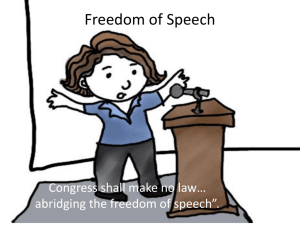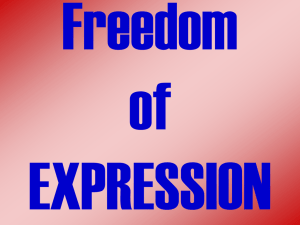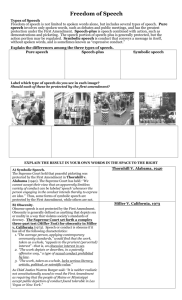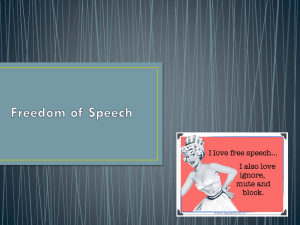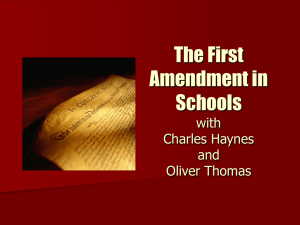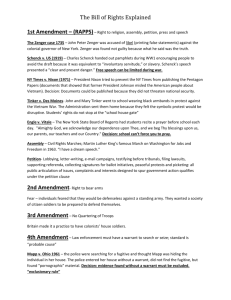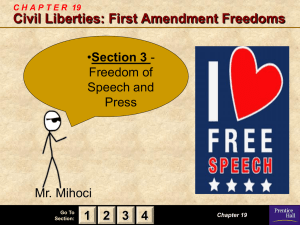Agenda - Rebel Rule
advertisement
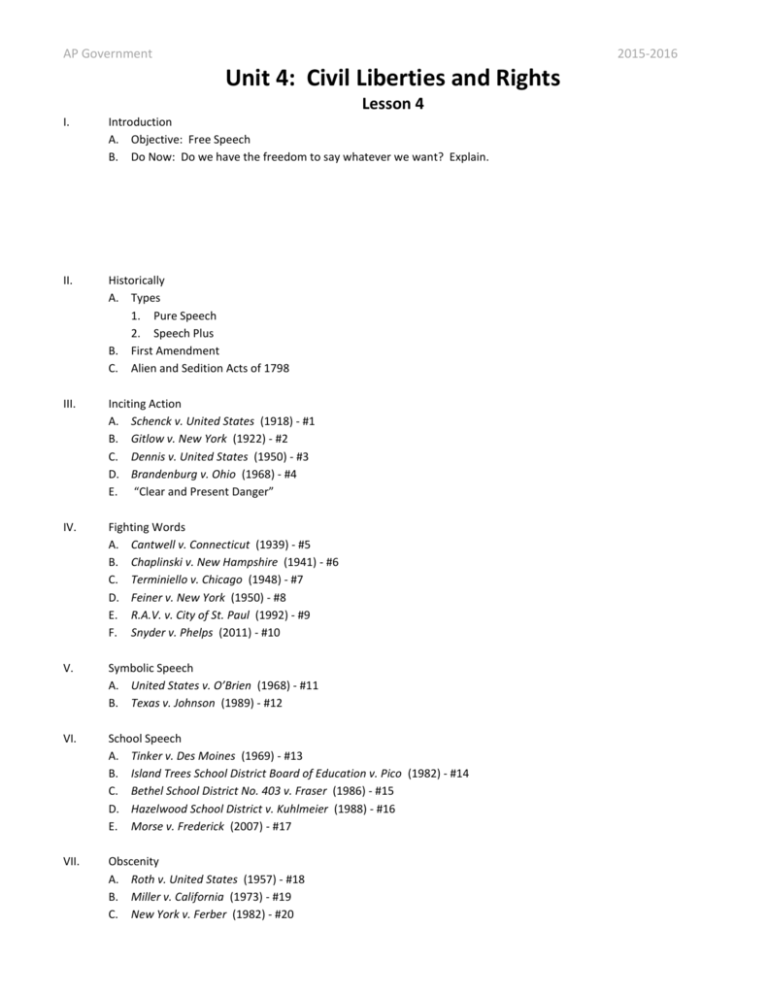
AP Government 2015-2016 Unit 4: Civil Liberties and Rights Lesson 4 I. Introduction A. Objective: Free Speech B. Do Now: Do we have the freedom to say whatever we want? Explain. II. Historically A. Types 1. Pure Speech 2. Speech Plus B. First Amendment C. Alien and Sedition Acts of 1798 III. Inciting Action A. Schenck v. United States (1918) - #1 B. Gitlow v. New York (1922) - #2 C. Dennis v. United States (1950) - #3 D. Brandenburg v. Ohio (1968) - #4 E. “Clear and Present Danger” IV. Fighting Words A. Cantwell v. Connecticut (1939) - #5 B. Chaplinski v. New Hampshire (1941) - #6 C. Terminiello v. Chicago (1948) - #7 D. Feiner v. New York (1950) - #8 E. R.A.V. v. City of St. Paul (1992) - #9 F. Snyder v. Phelps (2011) - #10 V. Symbolic Speech A. United States v. O’Brien (1968) - #11 B. Texas v. Johnson (1989) - #12 VI. School Speech A. Tinker v. Des Moines (1969) - #13 B. Island Trees School District Board of Education v. Pico (1982) - #14 C. Bethel School District No. 403 v. Fraser (1986) - #15 D. Hazelwood School District v. Kuhlmeier (1988) - #16 E. Morse v. Frederick (2007) - #17 VII. Obscenity A. Roth v. United States (1957) - #18 B. Miller v. California (1973) - #19 C. New York v. Ferber (1982) - #20 AP Government VIII. 2015-2016 Conclusion A. The concept of free speech has been constantly challenged, re-evaluated, and redefined since the Constitution was first created. B. The country and the culture have evolved beyond what the Framers of the Constitution envisioned. The Supreme Court has repeatedly ruled on when speech is allowed and when speech is prohibited. C. The Supreme Court has historically been reluctant to limit speech unless it is slanderous, egregious, a threat to public safety, or a national security risk. These instances are often difficult to pinpoint, and courts generally err on the side of protecting speech. D. Most forms of symbolic speech are protected; however, there are limitations. For example, the government is often allowed to regulate speech that occurs in a public forum or in special facilities such as military bases, schools, and prisons. Other limits of free speech involve obscenity, defamation, commercial speech, and speech that leads to unlawful action. Key Terms, Concepts, Events, People, and Places: Pure Speech Speech Plus Espionage Act of 1917 Schenck v. U.S. “Clear and Present Danger” “Dangerous Tendency” Test First Amendment Alien and Sedition Acts Gitlow v. NY Brandenburg v. Ohio Fighting Words Chaplinsky v. New Hampshire Tinker v. Des Moines Snyder v. Phelps Symbolic Speech Texas v. Johnson Hazelwood v. Kuhlmeier Roth v. U.S. Miller v. California Questions to Consider: 1. What is the difference between Pure Speech and Speech Plus? Why must a distinction be made? 2. How would you explain the “Clear and Present Danger” limit on our freedom of speech? Back up your explanation with cases. 3. Are “fighting words” protected under the First Amendment? Explain using cases. 4. What is symbolic speech and why is it protected by the First Amendment? Explain using cases. 5. How are First Amendment rights guaranteed to students? How are First Amendment rights limited for students? Explain using cases. 6. Is obscenity protected under the First Amendment? Explain using cases.

